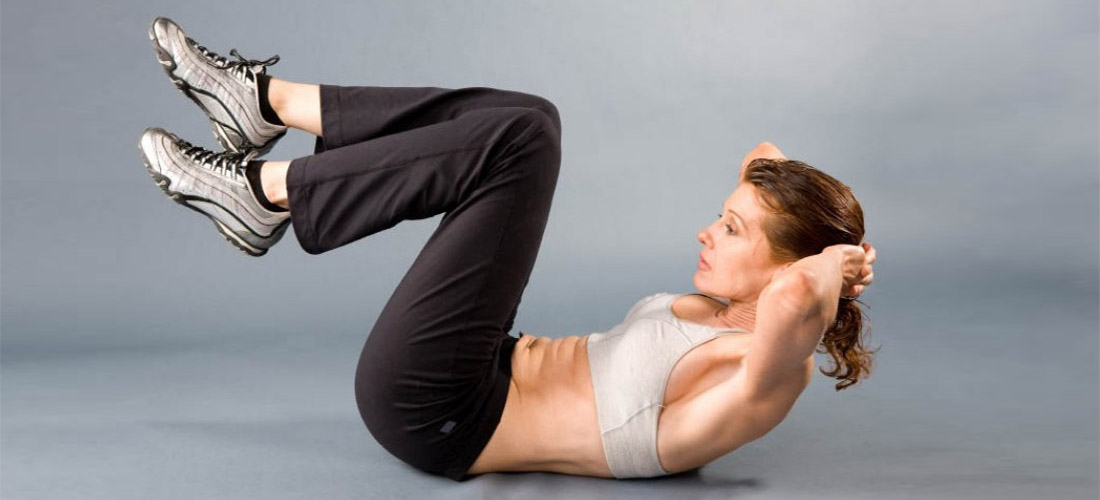Having a tough abdomen makes it easy for you to get to the harder exercises. Abdomen forms our most prominent part after workout. But you don’t have time for it. So why not read a little about ab exercises you can do almost anytime or with minimum assistance. Get it fast and flaunt it!
Here’re the 13 abdominal training exercises for your strengthened, stronger and mighty abdomen.
Contents
Pelvic Tilting (Lying)
Starting position
Begin by lying on your back with your knees bent. Place your feet and knees shoulder-width apart. Your arms should rest on the floor slightly away from your body.
Action
Tighten your abdominal muscles to tip your pelvis backward. Pause and then reverse the action, tightening your back muscles to hollow your back away from the floor. Repeat this action and try to stop the movement when you are halfway between the two extremes.
Note: This mid-point is your neutral position and we will use it later in the program.
Points to note
Keeping the knees apart allows the pelvis to move unhindered. If the knees are too close together, free movement of the pelvis will be restricted.
Training tip
The action must be smooth and controlled rather than jerky. A jerking action will stress the lower spine.
Pelvic Tilting (Standing)
Starting position
Begin standing with your feet shoulder-width apart. arms by your sides. Stand tall. Do not slouch.
Action
Tighten your abdominal muscles and your buttock muscles together to tilt your pelvis back-wards and flatten your lower spine. Pause and then tighten your hips and spinal muscles to increase the hollow in the small of your back.
Points to note
The action should be isolated to your lower back. Your shoulders should stay square, and your knees should remain still. Avoid any body sway.
Training tip
Placing your hands out to the side in a ‘T’ shape will help with the balance of this exercise, and make any unwanted body sway more obvious. If you find it difficult to control body sway, place your hands on a wall in front of you.
Pelvic Tilt (Bench Sitting)
Starting position
Sit on a gym bench or dining chair with your knees bent and slightly apart. Your knees should be positioned slightly lower than your hips. Keep your back straight but not rigid, and feet flat on the floor.
Action
Sit tall and tilt your pelvis forwards to press your pubic bone towards the bench and hollow’ your lower back. Pause, and then tilt your pelvis backwards pressing your tailbone (coccyx) onto the bench and flattening your lower back.
Points to note
The movement must be isolated to the pelvis. Do not allow your body to sway and do not round or brace your shoulders.
Training tip
Make sure you keep your knees apart to allow unhindered motion of the pelvis.
Pelvic Tilting (On a ball)
Starting position
Sit on a large 60 cm (24 inch) gym ball with your knees bent to 90 degrees. Your back should be straight but not rigid, and your feet should be flat on the floor.
Action
Sit tall on the ball and tilt your pelvis back-wards to decrease the hollow in the small of your back, and then forwards to increase it.
Points to note
The movement must be isolated to the pelvis. Do not allow any body sway and do not round or brace your shoulders.
Training tip
To prevent body sway to begin with, place a dining chair at each side of the ball. Put each hand flat on the chair surfaces to monitor shoulder movement.
Abdominal Hollowing (Kneeling)
Starting position
Begin kneeling on all fours with your honds And knees shoulders width apart. Kneel on a mat or folded towel for comfort.
Action
Allow your tummy muscles to relax and sag downwards to the floor. Then tighten them and pull them up and in, trying to hollow your tummy and pull your tummy button (umbilicus) in towards the spine.
Points to note
Initially the amount of movement may be very small, but with practice you should notice 10-15 cm (4-6 inches) of movement in total. Breathe normally throughout the action; do not take a deep breath when trying to flatten vow tummy. Keep your spine still as you hollow, Do not arch the spine or tilt the pelvis.
Training tip
(i) Make sure you keep a true “box” position with your shoulders directly above your hands, and your hips directly above your knees. In this position it is easier to align your spine optimally.
(ii) Keep your spine stilt, and try to isolate the movement to your abdomen. If you find it hard to stop your spine moving, place a book on your spine to make you more aware of it (tactile feedback).
Abdominal Hollowing (Lying)
Starting position
Lie on the floor on a mat or towel with your arms either by your sides or folded forwards. Keep your feet comfortably apart. If you are lying on your front, place a folded towel beneath your forehead to avoid squashing your nose.
Action
Perform the abdominal hollowing action by pulling your tummy button inwards anti drawing your abdominal wall (tummy surface) off the floor.
Points to note
If you are a little overweight and have a little bit of a ‘pot belly’, you may not be able to do this exercise! Make sure that you draw your tummy in with abdominal muscle action alone; do not take a deep breath or lift your chest.
Training tip
Train with a partner and lie on a hand towel, folded length-ways, placed under your tummy. As you pull the muscles in tight in the hollowing action, your partner should be able to pull the towel sideways.
Abdominal Hollowing (Sitting)
Starting position
Sit on a stool with your knees apart. Sit tall with your back slightly hollow. Place one hand on your tummy and the other in the small of your back.
Action
Perform the abdominal hollowing action by pulling your tummy in and up away from your front hand, focusing your attention on your tummy button.
Points to note
When sitting, try to sit tall, rather than slouching or holding the trunk too rigid.
Training tip
Use your hands to monitor the neutral position of your spine and also to give you feedback about the abdominal hollowing action.
Abdominal Hollowing (Standing)
Starting position
Stand upright with your feet shoulder-width apart. Place your lower spine in its neutral position.
Action
Perform the abdominal hollowing action by focusing on your tummy button and pulling it in and up.
Points to note
Breathe normally throughout the movement; do not hold your breath. Make sure that your spine, hips and legs stay still. Isolate the movement to your tummy alone; do not flatten your back or tilt your pelvis.
Training tip
Begin by practicing this exercise standing side-on to a mirror. Place a belt loosely around your lower tummy. As you hollow, a gap should form between your tummy and the belt.
Abdominal Hollowing (Walking)
Starting position
Stand upright and pet form exercise abdominal hollowing action from standing.
Action
Perform the abdominal hollowing action as you walk for five steps, and then relax your tummy for rive steps. Repeat this action for a five minute walk, breathing normally.
Points to note
As you walk, make sure you do not hold your breath as you are concentrating. Do not breathe too deeply and hyperventilate as this will make you fed lightheaded.
Training tip
If you find you lose control of the coordination of abdominal hollowing and walking, stop, rest.
Multifidus Setting (Sitting)
Starting position
Sit at the edge of a stool with your knees and feet shoulder-width apart. Place your thumbs in the small of your back just above waistband level. They should be placed to the side of the bones of your spine (spinous processes), and pressed in to the skin gently.
Action
Gently draw your tummy in hollowing and at the same time, press your deep back muscles against your thumbs.
Points to note
The action must be restricted to your deep back muscles. You should not lean or push yourself back, nor hollow or flatten your spine substantially. Only a small local movement of the spinal bones should be felt. Because your knees are apart, you begin with your lower spine slightly hollow. As the multifidus muscle contracts, it will gently deepen the lumbar curve to bring you back towards the neutral back position.
Training tip
Most people find it difficult to feel this muscle contract, so persevere; it is often what you don’t feel which is important. As you tighten your back muscles, you should not feel the large columns of muscle at either side of the spine tighten (the erector spinae muscles). Try to focus the muscle action to within 2 cm (1 inch) of the center of the back. It is helpful to perform a pelvic floor contraction at the same time as tightening the multifidus.
Multifidus Setting (Standing)
Starting position
stand with your feet apart and place your left thumb into the gap between your spinal bone and the erector muscles of your back on the left hand side
Action
Gently draw your tummy in (hollowing) and see if you can detect your multifidus muscle swelling beneath your fingers. Next, lift your right arm in limit of you to the horizontal, keeping ii straight. Again see if you can feel the multifidus switch on.
Points to note
Try to time the abdominal hollowing and arm lifting together, gently drawing your tummy inwards as your lift your arm.
Training tip
Because multifidus contraction is so subtle, it sometimes helps to close your eyes to really focus your attention on what your fingers are feeling. It can take a couple of training sessions before you feel the muscles switch on so be sure to persevere!
Pelvic Floor Contraction (Crook Lying)
Starting position Lie on the floor with the knees and feet slightly apart. Relax your buttock muscles (gluteals) and the muscles which pull your legs together (adductors).
Action
Slowly tighten (draw up) the muscles around your back passage (anus). Hold this feeling and try to take it forward to tighten the muscles around the vagina (female) or to lift the penis slightly (male). The feeling should be as though you are trying to stop yourself passing Water. Hold for a count of five (breathing normally) and then release.
Points to note
This action is just as important in the male as the female because the pelvic floor muscles work with the deep abdominal muscles in core stability. In addition, the pelvic floor muscles work to prevent ‘dribbling’ of urine (incontinence, and to help maintain an erection in the male. Try to perform the action without tensing the gluteal or adductor muscles.
Training tip
Although the action should feel the same as trying to stop the passage of urine, do not perform the action while actually passing urine. This is because this action may interfere with the natural reflexes which control the bladder, making it hard to pass urine in the normal way.
Pelvic Floor Contraction (Sitting)
Starting position
Sit on a firm chair or gym bench with your knees and feet slightly apart. Make sure you sit up straight (tall), do not allow yourself to slouch. Relax your buttock muscles (gluteals) and the muscles which pull your legs together (adductors).
Action
Slowly tighten (draw up) the muscles around your back passage (anus). Hold this feeling and try to take it forwards to tighten the muscles mound the vagina and pull up inside you (female) or to lift the penis slightly (male). The should be as though you are trying to stop yourself passing water. Hold for a count or 3-5 (breathing normally) and then release.
Points to note
This action is just as important in the male as it is in the female, because the pelvic floor muscles work with the deep corset muscles in core stability. Although the action should feel the same as trying to stop the passage of urine, do not perform the action while actually passing urine the action may interfere with the natural reflexes which control the bladder, making it hard to pass urine in the normal way.
Training tip
Try to practice the action regularly throughout the day. Tighten the pelvic floor muscles every hour when you are sitting at your desk, or when driving and sitting at the traffic lights for example.
Practice them often to get the best abs. For increasing the core strength, you might wanna read, “20 Amazing Ab Exercises To Build A Strong Core” For more beginner stuff, jump to “The Beginner’s Guide To Pack Abs & Core”







Comments are off this post!